(in development)
Who says that good ergonomics has to cost a lot? Here are 50 useful techniques that you can apply at little or no expense for common issues. Depending upon the circumstances, many can yield dramatic improvements for saving both time and effort.
These ideas are all linked to further information on similar issues and options.
Material handling
1. Reduce bending: Fixed-height pallet/container stand
 |
| Fixed height stand for pallets and containers |
One of the most common problems is having to lift items from floor level, which takes extra time and can strain the back. Under many circumstances, a fixed-height stand is all that is needed to raise items to a better height. Platforms for pallets and containers do not necessarily need to be adjustable to be “ergonomic.” What matters is having materials at a good working height. Heights provides background information on establishing good working height. There are multitudes of different styles of pallet and container lifts useful in different situations.
2. Eliminate lifting/carrying: Use slides
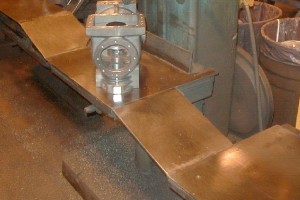 |
| Slides can be inexpensive andeffective |
One of the most underused techniques is providing slides for heavy loads. Slides have many advantages: (1) cheap to install, (2) easy to configure for different applications, (3) require little or no maintenance, (4) usually safer than suspending a load by a hoist, (5) often faster than other mechanical systems, and (6) somewhat instinctive to use so often usage is better than hoists. It is almost always better to slide a load than pick it up and put it down.
3. Eliminate lifting/carrying: Skid bar
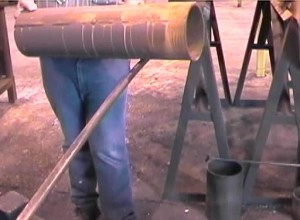 |
| Skid bar |
This length of pipe serves as a slide to hold the weight of a heavy cylinder as it is moved from one machine to another. In this case, perhaps a wider surface or roller conveyor would be better, but the point it shows is that a thin pipe can be sufficient, which is a factor that can be handy in constrained areas where nothing bigger would fit.
4. Eliminate lifting/carrying: Short conveyor
 |
| Mini-conveyor to bridge gap |
Conveyors are commonly used ergonomic devices. We usually think of conveyors for longer distances, but there’s no reason not to use very short lengths to eliminate the need to lift. They can be used anyplace where items have to be picked up and put down, such as in the photo above to bridge a small gap between a workstation and a larger conveyor.
5 & 6.
7. Homemade air conveyor
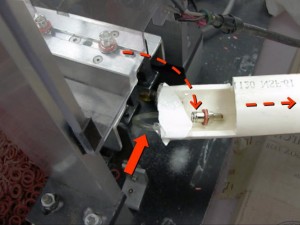 |
 |
| Small parts drop down into PVC pipe and air jet (heavy arrow) blows them out across a long table | |
An air conveyor sounds complicated and expensive, but doesn’t have to be. The photos above show a version that is homemade with a PVC pipe. A thin tube of shop air blows towards the pipe (thick arrow in photo at left). When the small parts drop from the machine (dotted arrow) they hit the air jet and are whisked down the pipe to the point of use. This simple device eliminated the need to pick up a loaded basket and carry it around to the other side of a table.
8. PVC channel conveyor
 |
| PVC pipe for conveyor |
Here’s another version of a PVC pipe with a slot cut for steel rings. The application in the photo is to transfer the parts from one machine to another, but obviously the idea could be used anywhere for items that roll. The PVC conveyor above eliminated the need to manhandle and move the parts in baskets.
9. & 10. The wheel
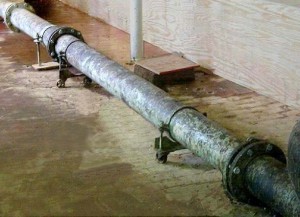 |
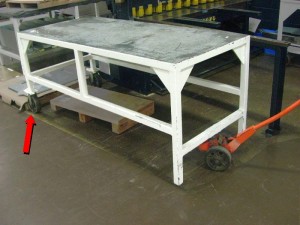 |
| For section of pipe (regularly removed to clean the system) | For a steel table (with old-fashioned lever dolly) |
The wheel is good — it’s proven technology. Wheels can be added to many heavy items that must be moved around. Sure, a forklift truck or some equivalent powered unit, might be better, but we’re talking low-cost options. There’s a lot of information about wheels here.
11
Cart rather than carry
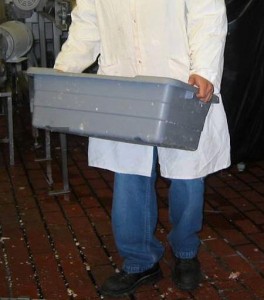 |
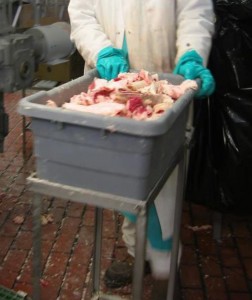 |
| Carts were invented thousands of years ago . . . for good reason | |
Rather than carrying a heavy load, use a simple waist-high cart. Carts can be fabricated in-house or purchased at relatively low cost. Moreover, they can usually be easily customized to fit specific situations. There is no limit to the styles of carts that are available or can be created. See carts.
Workstations
12
Avoid bending: Orient vertically
 |
 |
| Horizontal | Vertical |
An incredibly simple technique that is often overlooked is orienting long or flat items vertically, thus eliminating the need to bend. Vertical orientation often saves floor space too. See work area storage.
13
Reduce reaches: Adjust shelves
 |
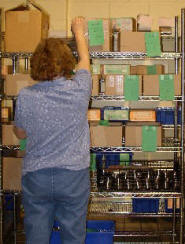 |
| Five minutes to adjust the shelves (not perfect, but better, especially when cost free.) | |
Many shelving units are adjustable, but never set for the materials they hold. Look for unused vertical space in racks. Try to keep everything below the shoulders and above the knees, but any improvement can be beneficial. More examples are in work area storage.
14
Reduce time and motions, Improve layouts
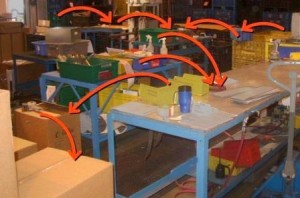 |
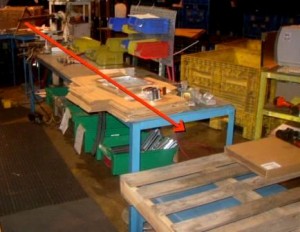 |
| Before: Wasted steps | After: Smoother flow |
It took a team about 45 minutes and no out-of-pocket costs to straighten this work area.
15
Reduce pressure points, provide cushioning
 |
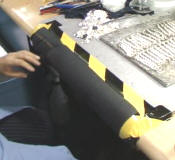 |
| Before: Hard edge | After: Pipe wrap |
Contact stress (or pressure points) is often one of the easiest issues to resolve, at least with quick fixes. There are many readily available materials that can be used: pipe wrap, tape, shop cloths, etc. See Arm supports as well as Principle 7 Pressure Points.
16
Avoid bending: Add a handle
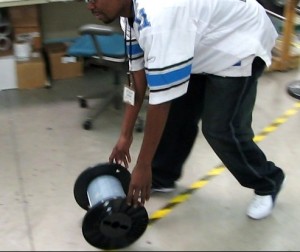 |
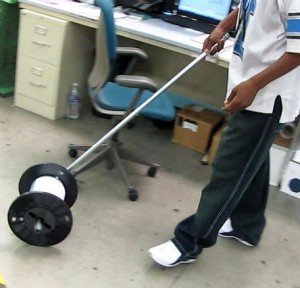 |
| Before: Roll spool | After: Long handle |
In this plant
See Hand tools: long handles
17
Avoid bending: Use a broom handle.
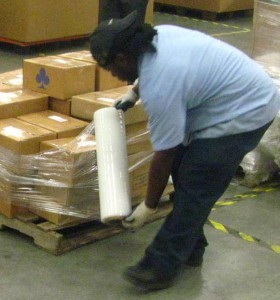 |
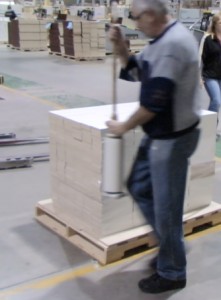 |
| Harder | Easier |
Stick a broom handle or equivalent through the roll to avoid having to bend while adding stretch wrap. See packing, labeling/taping, and stretch wrapping
18
Avoid bending: Bungee cords for deep container
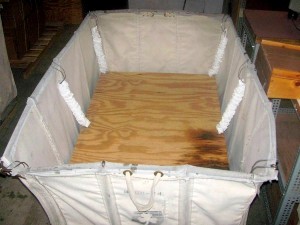 |
| False bottom and bungee cords |
Add a false bottom and bungee cords to create a spring-loaded container. See containers for more ideas on ways to reduce the need to bend.
19
Slippery or small tools? Use vet wrap
 |
 |
| “Vet wrap” on tweezers (with and without) | Roll of vet wrap |
Self-adhering bandages from a drug store can work wonders around slippery tools. In addition to creating a better friction grip, it pads pressure points and can increase grip size to make small tools easier to hold. “Vet wrap” is designed for animals and brightly colored, available at pet stores and farm supply stores.
20
Reduce strain on hands: Take advantage of fixtures
 |
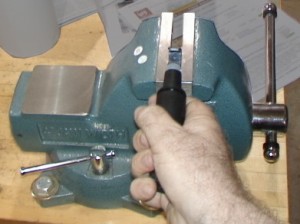 |
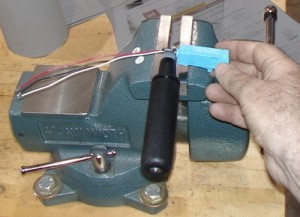 |
| Before: Wire stripper with thumb push | After: Place end in vise, pull open with full hand | |
The example above shows a hand wire stripper that requires pushing the end piece open with the thumb to place the wire. The end piece is spring-loaded, which is slow and tiring for the thumb when done repetitively.
A zero-cost solution was to use an adjacent vise. By fixing the end piece in the vise, the full hand can be used to pull the end piece open, taking advantage of much larger muscle groups. Seefixtures.
21
Lighten the load: Use a cradle
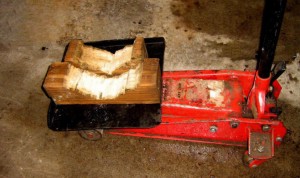 |
| Notched out wood cradle on top of car jack |
Cradles a great way to eliminate lifting and holding while in an awkward position.
22
Lighten the load: Use a cradle
Machine loading cradle
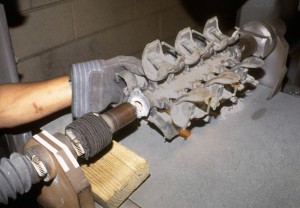
2×4
23, 24
Conveyor stops
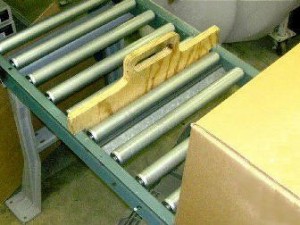 |
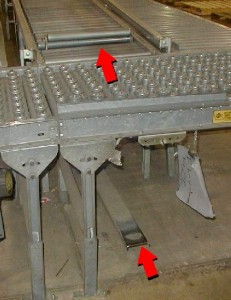 |
 |
25
Reduce glare: Hang a baffle
 |
 |
| Before: Glare | After: Quick fix baffle |
26
Reduce reach: Diverter for wide conveyor
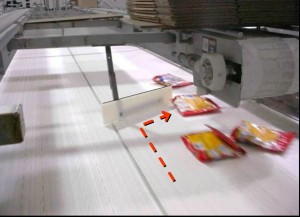
27
Footrest from honeycombed packing cardboard
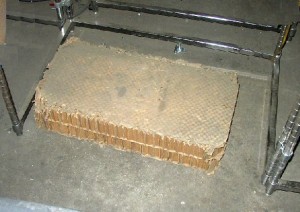
strong and lightweight, recycled
28, 29
Reduce bending, workbench height adjustment
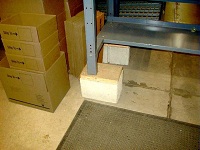 |
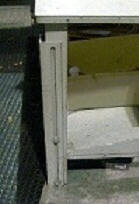 |
| Cement block | Angle iron, slot, and bolt |
30
Milk crate workbench platform
 |
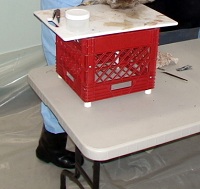 |
| Before: bending | After: milk crate platform to raise work surface |
See workstation height adjustment.
31
Reduce shoulder fatigue: Built-in arm support
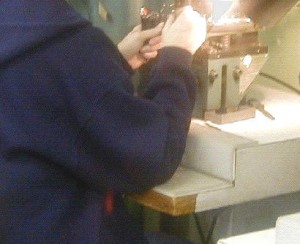
Lip on table creates arm rest See workstation arm supports
32
Long reach for tool
 |
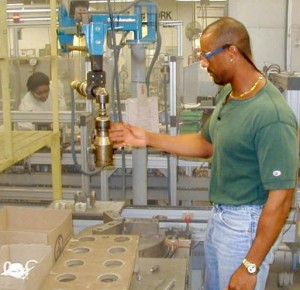 |
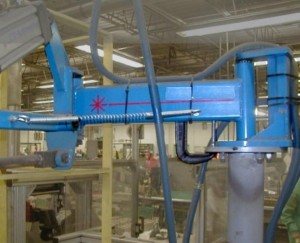 |
| Before: Reach | After: Close at hand | Solution: Spring and C-clamp |
x
x
33
Reduce reaching: Small turntable
x
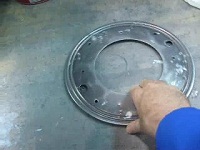
x
34
Guitar pick
 |
| Thumb pick |
The author successfully implemented the use of a thumb pick in a manufacturing plant to peel off labels on parts, replacing an awkwardly held screwdriver.
35
Suspended hook (1)
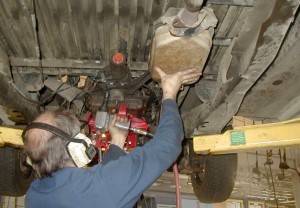 |
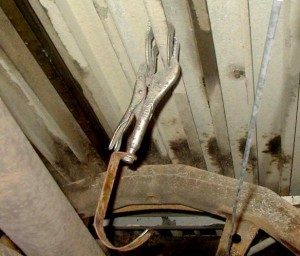 |
| Before: Hold exhaust system with one hand | After: Homemade hook |
Tired of holding an item up in the air? Add a simple hook.
The example above involves vehicle mechanics. To remove an exhaust system for repairs, it is necessary to hold the catalytic converter and exhaust pipes in place with one hand while removing the bolts with the other. This is an awkward position for holding a rather heavy load for a few minutes, plus it means that only one hand is available to do the work of removing all the bolts. By using a simple homemade hook to keep the exhaust system in place, the strain on the shoulder is eliminated and both hands are free to remove the work, which consequently was accomplished in about 40% less time.
36
Suspended hook (2)
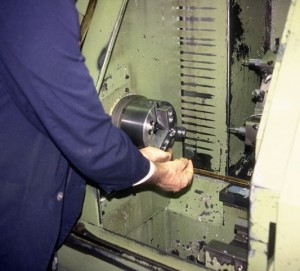 |
 |
| Before: Manually hold chuck | After: Hook and chain |
At a high precision machine shop, a lathe operator experienced shoulder problems from changing chucks, and ultimately needed surgery. The problem was having to hold the chuck in place with one hand extended away from the body while using an Allen wrench to attach or detach the chuck.
The operator requested a hoist, as was used in nearby larger machines. However, congestion in the area precluded this option. Brainstorming led to the use of a chain hung from the lathe splash door track to support the chuck. The chuck and chain still needs to be lifted in and out, but the time required to hold the load extended away from the body was reduced from minutes to a fraction of a second.
Total time from the start of the evaluation to the installation of the chain was two hours, including the time it took the machine shop to tap several screw holes in the chuck.
37
Long-handled dust pan
 |
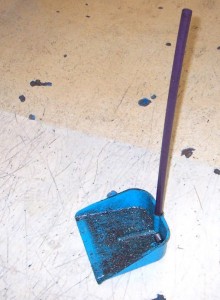 |
| Bending | Long handle |
Applies to every workplace, building, or household.
38
Cut a hole in a workbench surface
 |
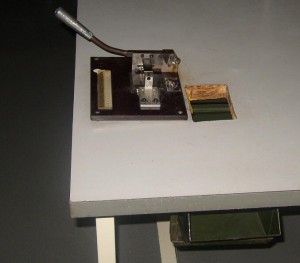 |
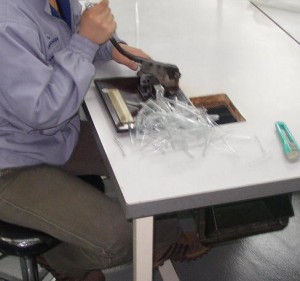 |
| Meat plant, holes in work surface for fat and trim |
The meat industry routinely uses holes cut in work surfaces for trimjmings.
Repetitive motions
slide
double handling
x
x
Topic
x
x
x
x
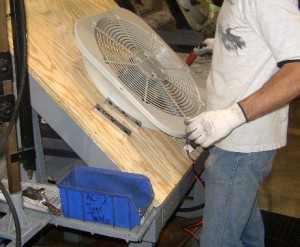
Conveyor gates
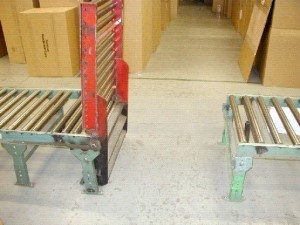 |
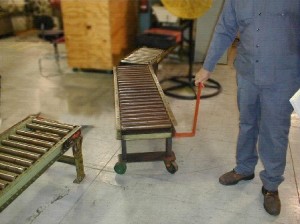 |
| Counter-balanced gate | Roll out gate (with handle) |
Conveyors and slides are effective, but they tend to block access to work areas. The answer is to use gates. There are many styles and variants of friendly, easy-to-open gates that could be used to a greater extent throughout industry. Note that both of the above gates are homemade modifications. The counterbalanced versions at left could literally be opened and closed with a single finger.
Dumpers
Adding rings to a standard trash receptacle enables a forklift to raise and dump the load. See dumpers.
x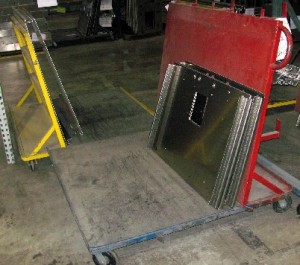
S
Simple slanted frame instead of powered tilter
Conveyor gates
x
x
x
Wheels can be added to about anything to make it easier to move.
Bike repair stand
x
Topic
x
x
x
Maintenance
Removing covers
x
x
Link to favorite low cost
x
x
See prints and specs better.
Topic
x
x
Hand tools
Collar
Home made collar (arrow)
A “collar” is a band of some type that provides a surface to push against, used primarily when you exert coaxially with the tool. Without it, you often need to squeeze harder to create the same force. The photo above shows a steel ring that was fabricated and added in-house, but you can use anything that provides the same effect, such as clamps or multiple layers of masking tape.
Self-closing pliers
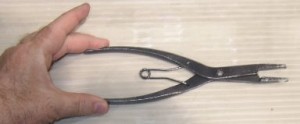 |
 |
| Self-closing pliers | Employee quick fix using rubber bands on jaws (and o-rings on handle for better grip) |
Self-closing tools incorporate a spring or clamp that keeps the jaws in a closed position. You squeeze to open the jaws, not the other way around. See Hand fixtures other types of hand-held clamps. See also Principle 6 Static Load.
Benchtop fixtures
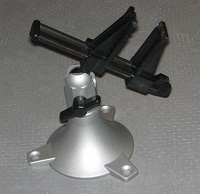 |
|
x
x
 |
|
x
Add a drop-down handle to a cart to avoid bending when moving
Adjustable standing platform
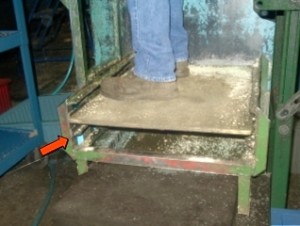 |
| “Oven rack” style stand |
x
False bottom to eliminate bending
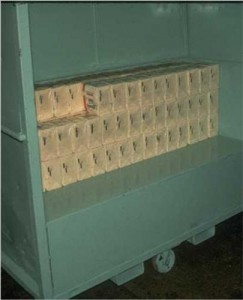 |
| Sheet metal added to raise a low surface |
Add a false bottom rather than bending down to a surface that is too low. See carts.
x
x
x
Heavy carts, larger wheels
Wheels too small
Industrial-sized wheels
Put larger wheels on heavy carts. See carts.
Door for deep container
x
Add hinges to a side of a deep container to create a door and eliminate a deep bend. See containers
List of ideas
Workstations |
Material Handling |
Hand Tools |
Machines |
Maintenance |
|
|
|
|
|
